2003 Oldsmobile Alero tow
[x] Cancel search: towPage 276 of 354
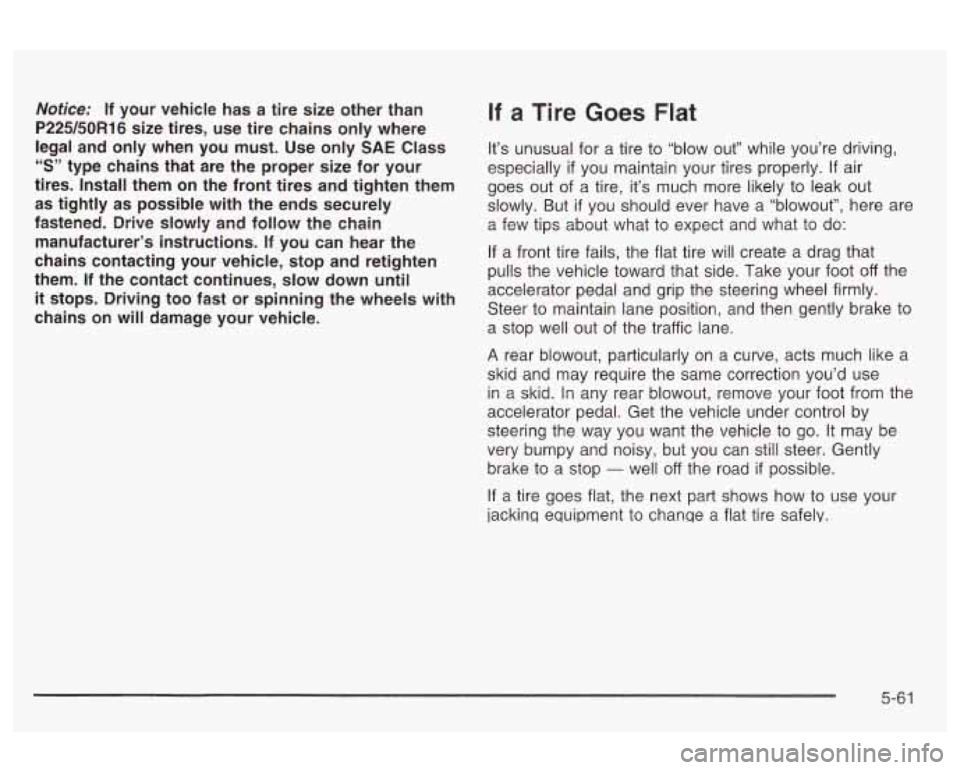
Notice: If your vehicle has a tire size other than
P225/50R16 size tires, use tire chains only where
legal and only when you must. Use only
SAE Class
“S” type chains that are the proper size for your
tires. Install them on the front tires and tighten them
as tightly as possible with the ends securely
fastened. Drive slowly and follow the chain manufacturer’s instructions.
If you can hear the
chains contacting your vehicle, stop and retighten
them.
If the contact continues, slow down until
it stops. Driving too fast or spinning the wheels with
chains on will damage your vehicle.
If a Tire Goes Flat
It’s unusual for a tire to “blow out” while you’re driving,
especially
if you maintain your tires properly. If air
goes out of a tire, it’s much more likely to leak out
slowly. But
if you should ever have a “blowout”, here are
a few tips about what to expect and what to do:
If a front tire fails, the flat tire will create a drag that
pulls the vehicle toward that side. Take your foot off the
accelerator pedal and grip the steering wheel firmly.
Steer to maintain lane position, and then gently brake to
a stop well out of the traffic lane.
A rear blowout, particularly on a curve, acts much like a
skid and may require the same correction you’d use
ir; a skid. In any rear blowoi:, rem0t.e yoi; foot from the
accelerator pedal. Get the vehicle under control by
steering the way you want the vehicle to go. It may be
very bumpy and noisy, but you can still steer. Gently
brake to a stop
- well off the road if possible.
If a tire goes flat, the next part shows how to use your
iackinq equipment to chanqe a flat tire safely.
5-61
Page 282 of 354
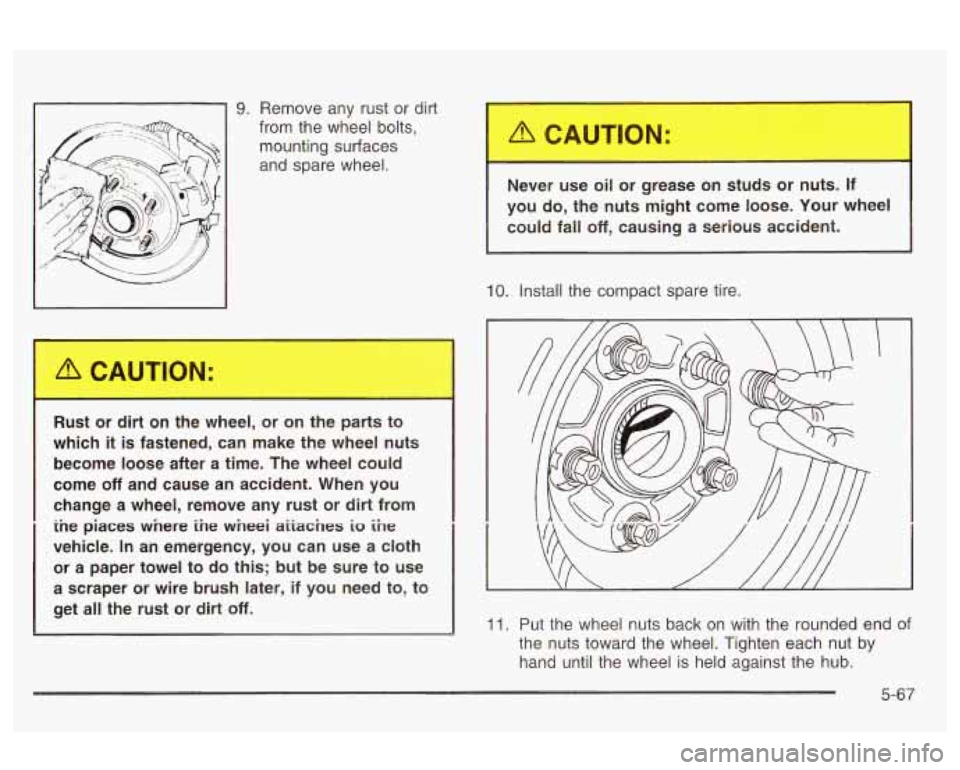
9. Remove any rust or dirt
from the wheel bolts,
mounting surfaces
and spare wheel.
R---t OL Art on the wheel, or on the parts to
which
it is fastened, can make the wheel nuts
become loose after a time. The wheel could
come
off and cause an accident. When you
change a wheel, remove any rust or dirt from
ine piaces wnere ine wneei aiiaches io ihe
vehicle. In an emergency, you can use a cloth
or a paper towel to do
this; but be sure to use
a scraper or wire brush later, if you need to, to
get all the rust or dirt
off.
Never use c or grease on studs or nl If
you do, the nuts might come loose. Your wheel
could fall
off, causing a serious accident.
10. Install the compact spare tire.
11. Put the wheel nuts back on with the rounded end of
the nuts toward the wheel. Tighten each nut by
hand until the wheel is held against the hub.
5-67
Page 288 of 354
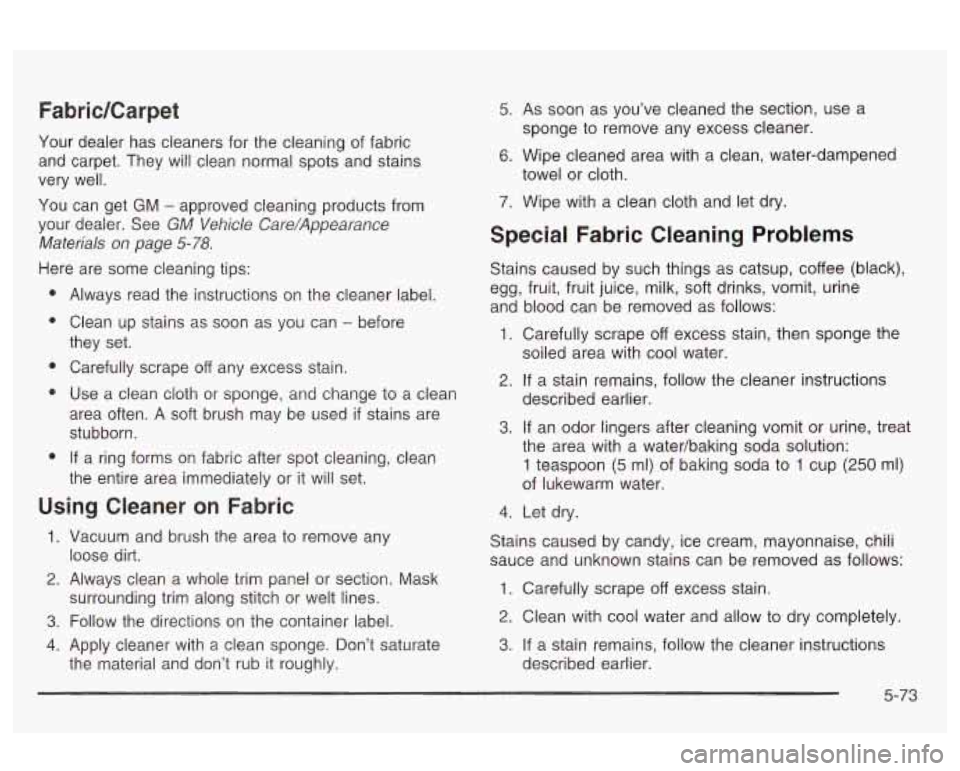
FabricKarpet
Your dealer has cleaners for the cleaning of fabric
and carpet. They will clean normal spots and stains
very well.
You can get GM
- approved cleaning products from
your dealer. See
GM Vehicle Care/Appearance
Materials
on page 5-78.
Here are some cleaning tips:
a
a
-.
Always read the instructions on the cleaner label.
Clean up stains as soon as you can
- before
they set.
Carefully scrape
off any excess stain.
Use
a dean cioth or sponge, and change io a cieari
area often. A soft brush may be used if stains are
stubborn.
If a ring forms on fabric after spot cleaning, clean
the entire area immediately or it will set.
Using Cleaner on Fabric
1. Vacuum and brush the area to remove any
loose dirt.
2. Always clean a whole trim panel or section. Mask
surrounding trim along stitch or welt lines.
3. Follow the directions on the container label.
4. Apply cleaner with a clean sponge. Don’t saturate
the material and don’t rub it roughly.
5. As soon as you’ve cleaned the section, use a
6. Wipe cleaned area with a clean, water-dampened
7. Wipe with a clean cloth and let dry.
sponge
to remove any excess
cleaner.
towel or cloth.
Special Fabric Cleaning Problems
Stains caused by such things as catsup, coffee (black),
egg, fruit, fruit juice, milk, soft drinks, vomit, urine
and blood can be removed as follows:
1. Carefully scrape off excess stain, then sponge the
2. If a stain remains, follow the cleaner instructions
soiled
area with cool water.
described earlier.
3. If an odor lingers after cleaning vomit or urine, treat
the area with a watedbaking soda solution:
1 teaspoon (5 ml) of baking soda to 1 cup (250 ml)
of lukewarm water.
4. Let dry.
Stains caused by candy, ice cream, mayonnaise, chili
sauce and unknown stains can be removed as follows:
1. Carefully scrape off excess stain.
2. Clean with cool water and allow to dry completely.
3. If a stain remains, follow the cleaner instructions
described earlier.
5-73
Page 290 of 354

Care of Safety Belts
Keep P+s clean and dry.
Do noi ,,,,ch or dye safety belts. If you do, it
may severely weaken them. In a crash, they
might not be able to provide adequate
protection. Clean safety belts only with mild
soap and lukewarm water.
Weatherstrips
Silicone grease on weatherstrips will make them last
longer, seal better, and not stick or squeak. Apply
silicone grease with a clean cloth at least every six
months. During very cold, damp weather more frequent
Fluids and Lubricants on page 6-15.
s.4~y,,”u..“. Qnnli,-Q+inn I I ml
I ,-J UY ha rqgIrpc!- spp Psfl !-J: .Rqc_nmrnended
Cleaning the Outside of
Your Vehicle
The paint finish on your vehicle provides beauty, depth
of color, gloss retention and durability.
Washing Your Vehicle
The best way to preserve your vehicle’s finish is to keep
it clean by washing it often with lukewarm or cold
water.
Don’t wash your vehicle in the direct rays
of the sun.
Use a car washing soap. Don’t use strong soaps
or chemical detergents. Be sure to rinse the vehicle
well, removing all soap residue completely.
You can get
GM-approved cleaning products from your dealer.
See
GM Vehicle Care/Appearance Materials on
page 5-78. Don’t use cleaning agents that are petroleum
based, or that contain acid or abrasives. All cleaning
agents should be flushed promptly and not allowed
to dry on the surface, or they could stain. Dry the finish
with a soft, clean chamois or an all-cotton towel to
avoid surface scratches and water spotting.
High pressure car washes may cause water to enter
your vehicle.
5-75
Page 292 of 354

Aluminum Wheels
Keep your wheels clean using a soft clean cloth with
mild soap and water. Rinse with clean water. After
rinsing thoroughly, dry with a soft clean towel.
A wax
may then be applied.
The surface of these wheels is similar to the painted
surface of your vehicle. Don’t use strong soaps,
chemicals, abrasive polishes, abrasive cleaners,
cleaners with acid, or abrasive cleaning brushes on
them because you could damage the surface. Do not
use chrome polish on aluminum wheels.
Don’t take your vehicle through an automatic car wash
that has silicone carbide tire cleaning brushes. These
brushes
cm also damage the surface of these whee!s.
Tires
To clean your tires, use a stiff brush with tire cleaner
Notice: When applying a tire dressing, always take
care to wipe
off any overspray or splash from all
pairlreu sur la~es VI I ule LJUUY VI V~lltGla btI=
vehicle. Petroleum-based products may damage the
paint finish and tires.
. . .I --- *I-- I--J.- _” ...L--l- +Lm
Sheet Metal Damage
If your vehicle is damaged and requires sheet metal
repair or replacement, make sure the body repair shop
applies anti-corrosion material to parts repaired or
replaced to restore corrosion protection.
Original manufacturer replacement parts will provide the
corrosion protection while maintaining the warranty.
Finish Damage
Any stone chips, fractures or deep scratches in the
finish should be repaired right away. Bare metal
will corrode quickly and may develop into major repair
expense;
Minor chips and scratches can be repaired with touch-up
materials avaliable from your dealer or other service
outlets. Larger areas of finish damage can be corrected
in your dealer’s body and paint shop.
5-77
Page 310 of 354
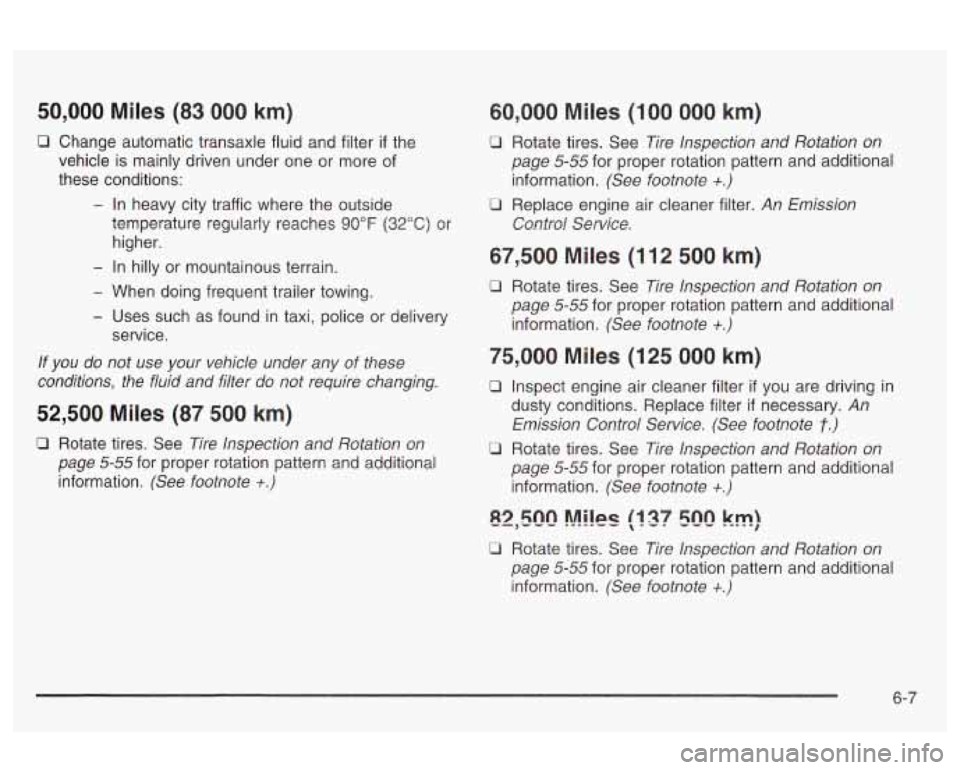
50,000 Miles (83 000 km)
0 Change automatic transaxle fluid and filter if the
vehicle is mainly driven under one or more of
these conditions:
- In heavy city traffic where the outside
temperature regularly reaches
90°F (32°C) or
higher.
- In hilly or mountainous terrain.
- When doing frequent trailer towing.
- Uses such as found in taxi, police or delivery
service.
If you do not use your vehicle under any of these
conditions, the fluid and filter do not require changing.
52,500 Miles (87 500 km)
c3 Rotate tires. See Tire Inspection and Rotation on
page
5-55 for proper rotation pattern and additional
information.
(See footnote +.)
60,000 Miles (100 000 km)
0 Rotate tires. See Tire Inspection and Rotation on
page
5-55 for proper rotation pattern and additional
information.
(See footnote +.)
0 Replace engine air cleaner filter. An Emission
Control Service.
67,500 Miles (1 12 500 km)
0 Rotate tires. See Tire Inspection and Rotation on
page
5-55 for proper rotation pattern and additional
information.
(See footnote +.)
75,000 Miles (125 000 km)
LI Inspect engine air cleaner filter if you are driving in
dusty conditions. Replace filter
if necessary. An
Emission Control Service. (See footnote
f.)
0 Rotate tires. See Tire Inspection and Rotation on
page
5-55 for proper rotation pattern and additional
information.
(See footnote +.)
U Rotate tires. See Tire Inspection and Rotation on
page
5-55 for proper rotation pattern and additional
information.
(See footnote +.)
6-7
Page 311 of 354
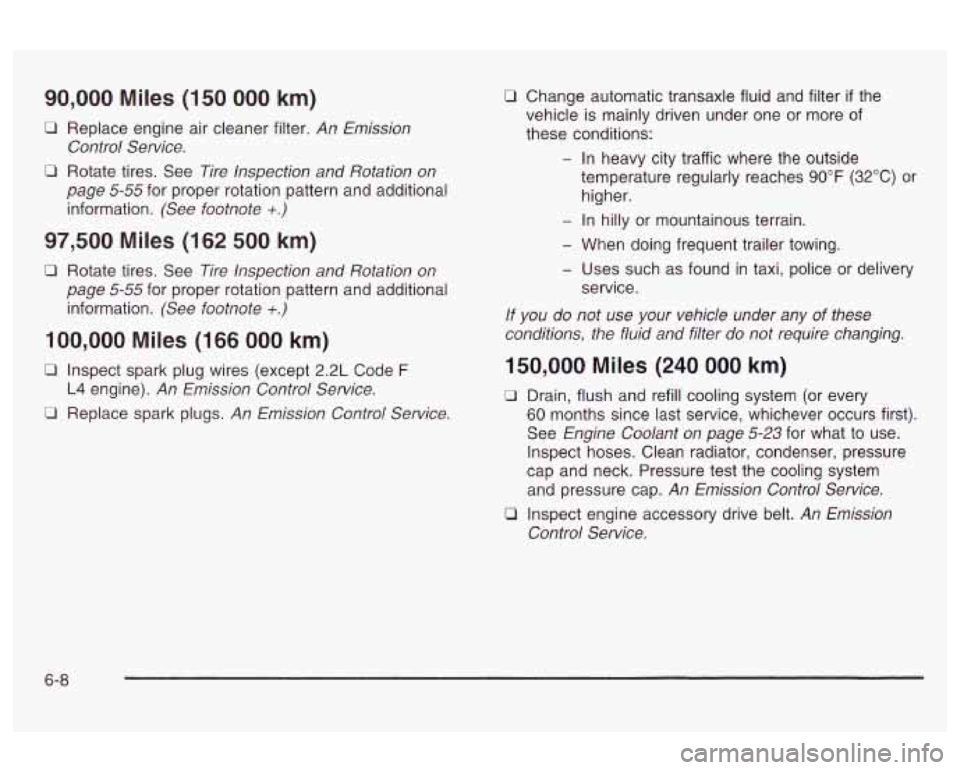
90,000 Miles (150 000 km)
0 Replace engine air cleaner filter. An Emission
0 Rotate tires. See Tire Inspection and Rotation on
Control Service.
page
5-55 for proper rotation pattern and additional
information.
(See footnote +.)
97,500 Miles (162 500 km)
0 Rotate tires. See Tire Inspection and Rotation on
page
5-55 for proper rotation pattern and additional
information.
(See footnote +.)
100,000 Miles (166 000 km)
0 Inspect spark plug wires (except 2.2L Code F
L4 engine). An Emission Control Service.
0 Replace spark plugs. An Emission Control Service.
0 Change automatic transaxle fluid and filter if the
vehicle
is mainly driven under one or more of
these conditions:
- In heavy city traffic where the outside
temperature regularly reaches
90°F (32°C) or
higher.
- In hilly or mountainous terrain.
- When doing frequent trailer towing.
- Uses such as found in taxi, police or delivery
service.
If you do not use your vehicle under any of these
conditions, the fluid and filter do not require changing.
150,000 Miles (240 000 km)
0 Drain, flush and refill cooling system (or every
60 months since last service, whichever occurs first).
See
Engine Coolant on page 5-23 for what to use.
Inspect hoses. Clean radiator, condenser, pressure
cap and neck. Pressure test the cooling system
and pressure cap.
An Emission Control Service.
0 Inspect engine accessory drive belt. An Emission
Control Service.
6-8
Page 326 of 354
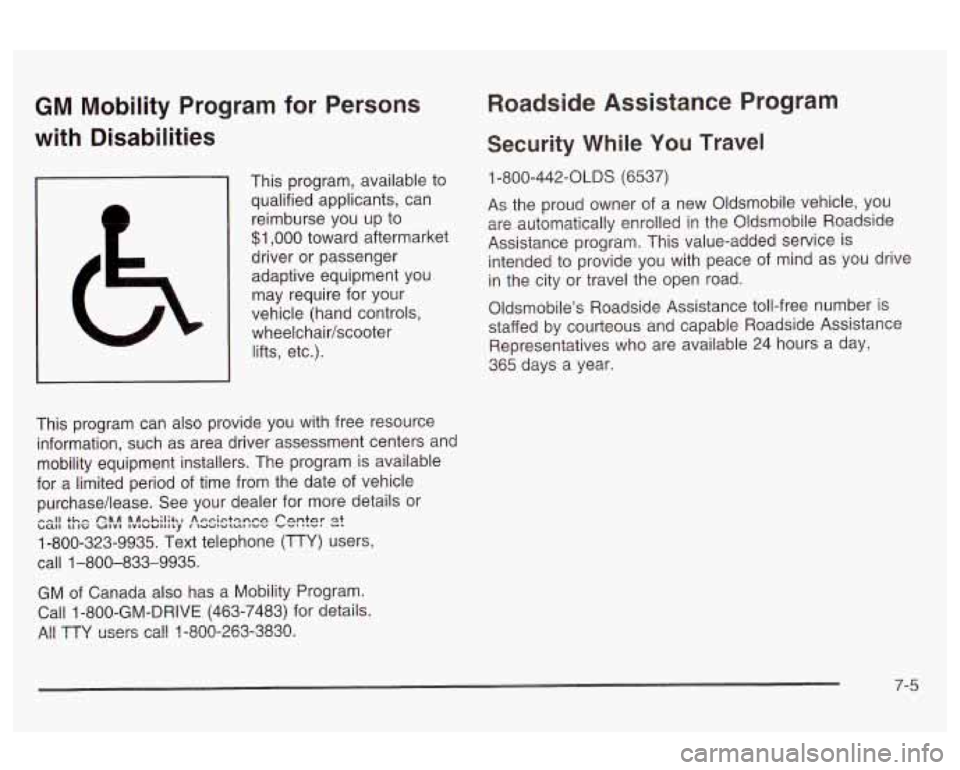
GM Mobility Program for Persons
with Disabilities
This program, available to qualified applicants, can
reimburse you up to
$1,000 toward aftermarket
driver or passenger
adaptive equipment you
may require for your
vehicle (hand controls, wheelchair/scooter lifts, etc.).
This program can also provide you with free resource
information, such as area driver assessment centers and
mobility equipment installers. The program is available
for a limited period of time from the date of vehicle
purchase/lease. See your dealer for more details or
1-800-323-9935. Text telephone
(TTY) users,
call 1-800-833-9935.
,-.-I1 +hn ehll htl,h;lit,, Ac-c-irtqnpn f‘nntnr 31 ball 11 IG UIVI IVIWUIIIL~ IW~IULUIIVV VVI I.V.
Roadside Assistance Program
Security While You Travel
1 -800-442-OLDS (6537)
As the proud owner
of a new Oldsmobile vehicle, you
are automatically enrolled in the Oldsmobile Roadside
Assistance program. This value-added service is
intended to provide you with peace of mind as you drive
in the city or travel the open road.
Oldsmobile’s Roadside Assistance toll-free number is
staffed by courteous and capable Roadside Assistance
Representatives who are available 24 hours a day,
365 days
a year.
GM of Canada also has a Mobility Program.
Call
1 -800-GM-DRIVE (463-7483) for details.
All TTY GS~S call 1-800-253-3830.
7-5